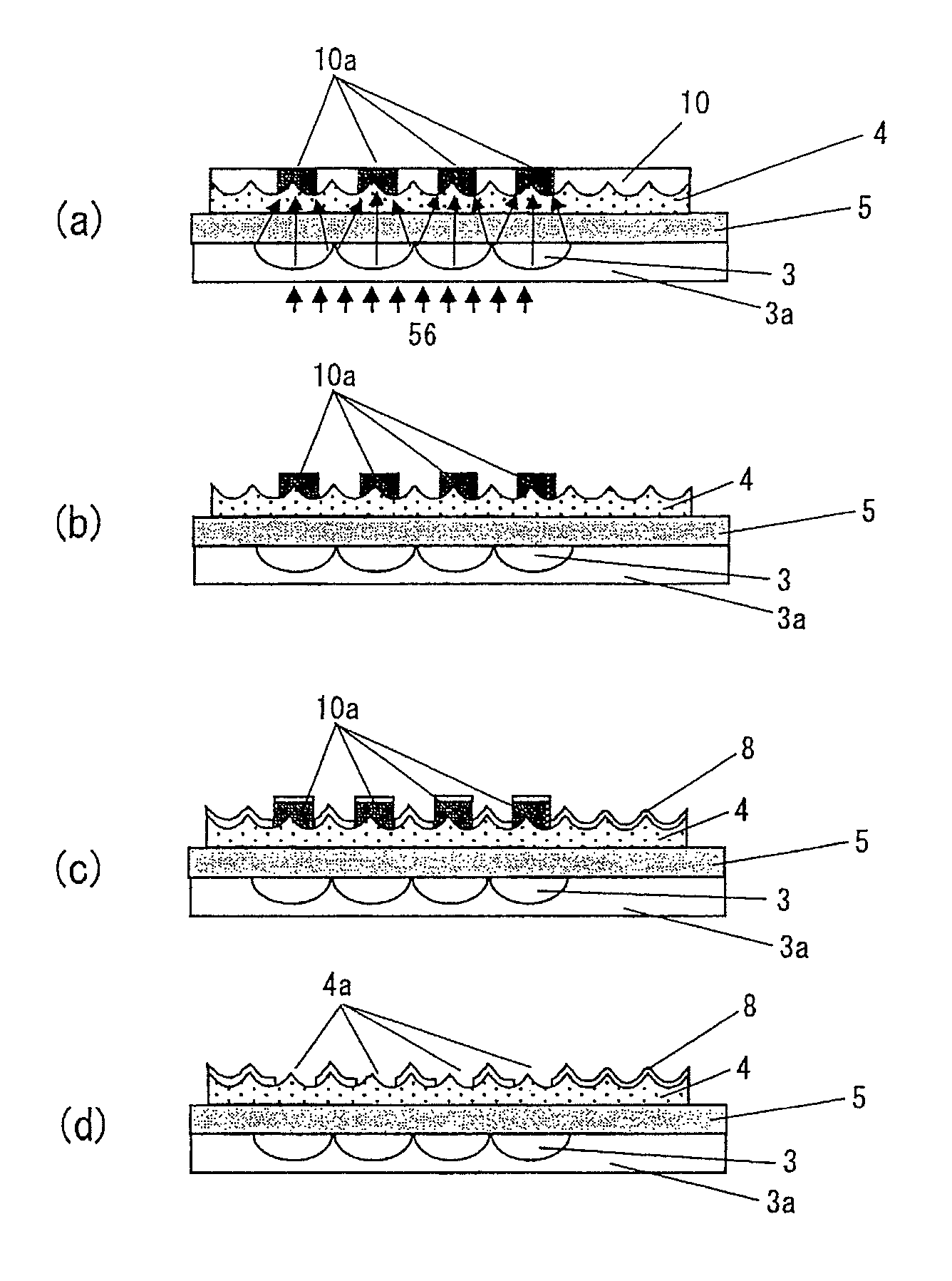Method for producing apertures in a diffuse reflector layer having a metal reflection film
a technology of metal reflection film and diffuse reflector, which is applied in the field of diffuse reflector type, can solve the problems of reducing the brightness produced by reflected light, reducing the efficiency of light collection, and not perfect positioning between the lenses and apertures, and achieves excellent visibility
- Summary
- Abstract
- Description
- Claims
- Application Information
AI Technical Summary
Benefits of technology
Problems solved by technology
Method used
Image
Examples
first embodiment
[0029]A first embodiment will be described. FIG. 1 is a sectional view of a transflective type liquid crystal display equipped with aperture-forming lenses and a diffuse reflector layer according to this embodiment. The liquid crystal display consists of display side members, a liquid crystal layer 7, and rear side members. The display side members include a color filter 9, a display side electrode 11, and an upper glass substrate 12. The liquid crystal layer 7 is interposed between the display side members and rear side members. The rear side members include aback light 1, a prism lens sheet 2, aperture-forming lenses 3, a flattening layer 3a, a diffuse reflector layer 4, a glass substrate 5, and a rear side electrode 6.
[0030]Apertures 4a are formed in the diffuse reflector layer 4. In the direction in which the light led from the back light 1 through the prism lens sheet 2 passes, the centers of the apertures 4a are coaxial with the center positions of the aperture-forming lenses ...
second embodiment
[0048]A second embodiment will be described with reference to FIG. 4. A liquid crystal display in FIG. 4 is the same as the one shown in FIG. 1 except that an aperture-forming lens-equipped film 20 is used instead of the aperture-forming lenses 3. The aperture-forming lens-equipped film 20 is pasted to the glass substrate 5. Since the film 20 is equipped with aperture-forming lenses 20a, it can collect light led from the back light 1 and pass it through the apertures in the diffuse reflector layer 4. Also, the aperture-forming lens-equipped film 20 has a flattening layer 20c under the aperture-forming lenses 20a to flatten a concave and convex pattern of the lenses.
[0049]FIG. 5 is an explanatory diagram illustrating a manufacturing process for forming the apertures 4a in the diffuse reflector layer 4 using the aperture-forming lens-equipped film 20. FIG. 5A shows the glass substrate 5 on which the diffuse reflector layer 4 is formed, where the upper surface of the diffuse reflector ...
third embodiment
[0053]A third embodiment will be described. This embodiment relates to a manufacturing method for an aperture-forming lens-equipped film. It will be described with reference to FIG. 6. FIG. 6 is a sectional view illustrating a process for manufacturing the aperture-forming lens-equipped film 20. FIG. 6A is a partial sectional view of a die used to manufacture the aperture-forming lens-equipped film 20. In FIG. 6A, lens-shaped concave curves 40a are cut on a surface of a die 40 using a cutting tool 41. Preferably, a diamond cutting tool is used as the cutting tool 41 because this will give superior surface roughness to the lens-shaped concave curves 40a of the die. As a result of the cutting, the die 40 is completed as shown in FIG. 6B.
[0054]The die 40 has the concave curves 40a. FIG. 6C is a sectional view of the aperture-forming lens-equipped film 20 consisting of the die 40, a microlens member 20a, and a base film 20b. The aperture-forming lens portion 20a installed on the base fi...
PUM
| Property | Measurement | Unit |
|---|---|---|
| thickness | aaaaa | aaaaa |
| thickness | aaaaa | aaaaa |
| thickness | aaaaa | aaaaa |
Abstract
Description
Claims
Application Information
 Login to View More
Login to View More - R&D
- Intellectual Property
- Life Sciences
- Materials
- Tech Scout
- Unparalleled Data Quality
- Higher Quality Content
- 60% Fewer Hallucinations
Browse by: Latest US Patents, China's latest patents, Technical Efficacy Thesaurus, Application Domain, Technology Topic, Popular Technical Reports.
© 2025 PatSnap. All rights reserved.Legal|Privacy policy|Modern Slavery Act Transparency Statement|Sitemap|About US| Contact US: help@patsnap.com



